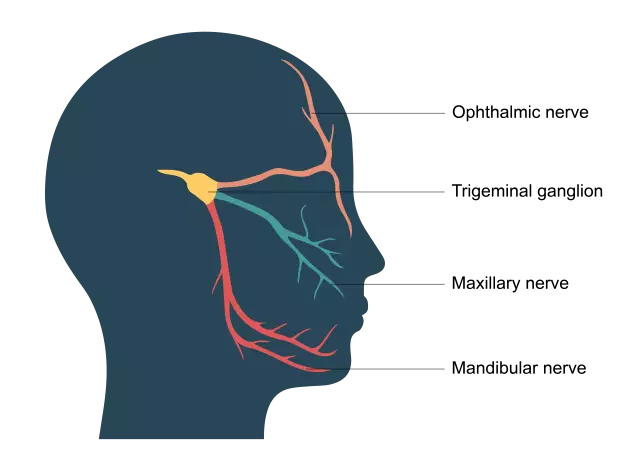- Author Rachel Wainwright [email protected].
- Public 2023-12-15 07:39.
- Last modified 2025-11-02 20:14.
Trigeminal neuralgia

A person who has suffered from trigeminal neuralgia will do anything to never face this disease again. The main reason for such an attitude is the strongest pains, which not only prevent the patient from living, but also bring him to the "last line", after which suicide attempts often follow.
In medicine, trigeminal neuralgia refers to pain that spreads along the trunk of the nerve. In this case, it affects the trigeminal nerve. It originates in the cranial cavity, then divides into three branches and comes to the surface in the cheeks, chin and temple. The trigeminal nerve provides a sensitive face of a person to heat, cold, touch, pain and other external influences.
Trigeminal neuralgia - causes of the disease
Severe pain is caused by traumatic effects on the nerve trunk, which happens with tumors, scar tissue changes, edema and tooth extraction or exposure to filling materials. In addition, when diagnosed with trigeminal neuralgia, symptoms are often attributed to hypothermia. Some other factors can also provoke the disease: infections, inflammatory diseases of the oral cavity and paranasal sinuses, metabolic disorders, and alcohol abuse. Mainly middle-aged and elderly people suffer from trigeminal neuralgia.
Trigeminal neuralgia - symptoms and clinical picture of the disease
As a rule, the first attacks begin in zone II and III of the branches (in the area of the nose, cheeks, upper jaw, lower jaw, lips, tongue, temple). From branch I (eyebrows, eyes, forehead), trigeminal neuralgia begins much less frequently. The pains are shooting, sharp, so it is no coincidence that many patients compare them to an electric shock. Painful sensations are accompanied by involuntary contractions of the facial muscles (tic, convulsions), and seizures can occur due to a variety of reasons - from chewing food to simple movements of the chewing muscles. The process is triggered by touching the so-called trigger points, which are located on the face and oral mucosa.
Usually, attacks do not last long - no more than 1-2 minutes, but due to severe pain, a person will remember these moments for the rest of his life. It is especially unpleasant that when diagnosed with trigeminal neuralgia, the patient may need treatment at any time of the day for at least several weeks.
In some cases, painful sensations do not last for several minutes, but for several days. In situations like this, doctors talk about the neurological status of the disease.
Trigeminal neuralgia - treatment and prognosis

Severe symptoms of trigeminal neuralgia, in particular pain and facial contractions, are stopped with the help of anticonvulsants, sedatives and pain relievers. Nerve blockade is almost always used - the introduction of prescribed funds directly into the area of the nerve. Medications should be taken under constant medical supervision, since many of them lose their effectiveness over time and require an ever higher dosage. Over time, a person begins to physically depend on drugs. The desire to reduce the intensity of pain is quite understandable, because with the diagnosis of trigeminal neuralgia, the symptoms appear really very clearly. However, patients and their families should be aware of the harmful effects of uncontrolled use of pain relievers and recognize the stage of physical addiction in time.
In addition to drugs, patients are prescribed:
- physiotherapy procedures (UHF, ultrasound, novocaine electrophoresis, diadynamic currents);
- reflexology;
- electrical stimulation of the affected endings of the trigeminal nerve.
If all of the above measures do not lead to the expected result, doctors decide on surgical intervention. Operations are divided into 2 types:
- interruption of the sensory nerve root directly in the cranial cavity. The destruction of nerve fibers is carried out in different ways. In most cases, when diagnosed with trigeminal neuralgia, treatment involves either the use of a laser or exposure to electrical discharges. The operation technique has been worked out to the smallest detail. It does not cause serious complications and is done under local anesthesia;
- when a nerve is compressed from all sides by blood vessels, it is advisable to perform a major neurosurgical operation of decompression of the trigeminal nerve. In such situations, surgery is more traumatic and therefore performed under general anesthesia.
The prognosis of treatment depends on the cause of the disease. Trigeminal neuralgia, symptoms of which are caused by trauma, responds well to treatment and does not recur. This is especially true for young people. A much worse prognosis for a disease provoked by metabolic disorders, since such trigeminal neuralgia is difficult to treat.
YouTube video related to the article:
The information is generalized and provided for informational purposes only. At the first sign of illness, see your doctor. Self-medication is hazardous to health!






